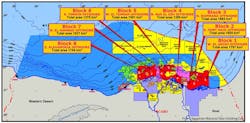Eni, BP take licenses offshore Egypt in 2015 bid round
Eni SPA and BP PLC have been awarded exploration rights to the 1,927-sq-km Block 4 and 1,389-sq-km Block 7 offshore Egypt following the 2015 Egyptian Natural Gas Holding Co. (Egas) bid round.
BP will operate Block 4, or North Ras El Esh, where interest is split 50-50 between BP and Eni. Eni will operate Block 7, known as North El Hammad, with 37.5% interest while BP will have 37.5%. Total SA is the third partner for Block 7, holding 25%.
BP also was awarded Block 14, North El Tabya; and Italy’s Edison SPA was awarded Block 12, Northeast Hapy, according to a statement from Egypt’s petroleum ministry.
Blocks 4 and 7 will be managed on behalf of Eni by affiliate International Egyptian Oil Co. (IEOC). Both blocks are in the shallow waters of the Mediterranean Sea, facing the Nile Delta and southwest of the Temsah area and west of the Baltim area, where Eni operates existing fields and production facilities (OGJ Online, Apr. 22, 2013).
The new concession agreements follow the award to Eni earlier this year of the deepwater Karawan and North Leil blocks (OGJ Online, Jan. 15, 2015), and further relaunch Eni’s exploration activity after recent successes at Nidoco NW and Zohr, the latter of which rivals other giant Mediterranean discoveries (OGJ Online, Aug. 31, 2015).
Eni has been present in Egypt since 1954. Current production totals 190,000 boe/d.
BP and partners last year committed to investing $240 million in Blocks 3 and 8, respectively known as North El Mataria and Karawan Offshore. (OGJ Online, Nov. 13, 2014). Block 8 was awarded in 2014 and is operated by Eni (OGJ Online, Sept. 25, 2014).
BP and Dana Gas earlier this year completed an agreement for drilling an exploration well on the 960-sq-km El Matariya onshore concession area, awarded to the companies last year, in Egypt’s Nile Delta (OGJ Online, June 2, 2015).
Also earlier this year, BP and a local partner signed final agreements for the West Nile Delta (WND) gas project, whereby $12 billion will be invested to develop 5 tcf of gas resources and 55 million bbl of condensates (OGJ Online, Mar. 6, 2015).

